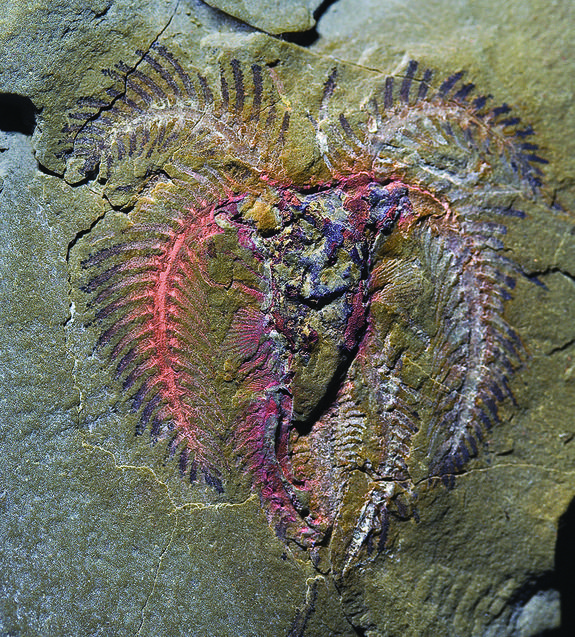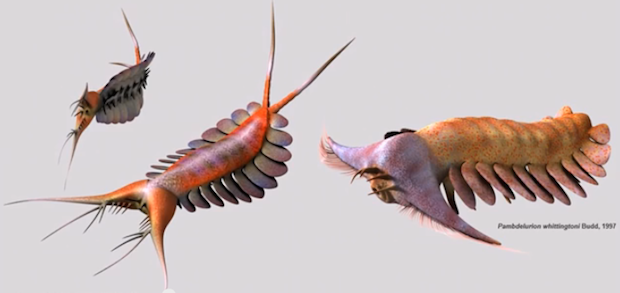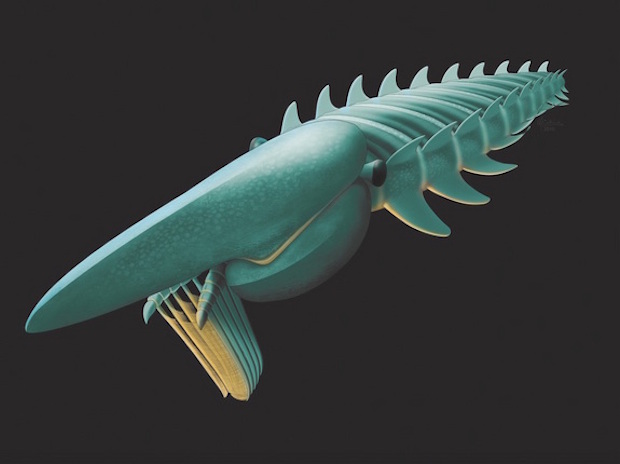Fossils of 400-million-year-old sea creatures found
Morocco's vast, rocky deserts were once covered with oceans teeming with life during the Ordovician period, about 485 million to 444 million years ago, a new study finds. But these stunning animals, now fossilized in mineralized splotches of violet, yellow and orange in the desert rock, would be unknown were it not for the tenacious work of a Moroccan fossil collector and a broke graduate student.
The Moroccan formation, known as the Fezouata Biota, holds some of the oldest known marine animals on Earth. It's home to more than 160 genuses, including an armored, wormlike creature (Plumulites bengtsoni) and a giant, filter-feeding arthropod (Aegirocassis benmoulae), according to the new study.
During the past few years, these newfound Fezouata fossils have rewritten evolutionary textbooks. A batch of horseshoe crab fossils show that the critters are about 25 million years older than was previously thought. What's more, the horseshoe crab fossils are incredibly complex, suggesting their ancestors evolved far earlier, said study lead researcher Peter Van Roy, a paleontologist at Yale University. [See photos of the extraordinary Fezouata Biota fossils]
In other cases, the Fezouata Biota shows that some animals survived the Cambrian, a period that lasted from about 541 million to 485 million years ago. For example, it was thought that anomalocaridids, an ancestor of modern-day arthropods such as butterflies and spiders, lived and died during the Cambrian.
But according to the Moroccan fossils, "they were still in existence 25 million years later, and they were flourishing and a major part of the ecosystem," Van Roy told Live Science.
Given the scarcity of Ordovician fossils, the Fezouata Biota sheds light on life that swam around during that period of ancient history, Van Roy said. In fact, fossil findings hint that two well-known events -- the Cambrian explosion, the sudden emergence of animals and the great Ordovician biodiversification event -- in which animals diversified and the number of marine genuses quadrupled -- may be the same event.
"What is emerging now is that actually these are not separate events, but that they are just two pulses in the same large-scale diversity dynamic," Van Roy said.
But getting to this point has been a long and storied path, he added.
Strapped for cash
Mohamed Ben Moula, a local fossil collector, discovered the exceptional remains at the Fezouata Biota in 2000. Researchers have known about the area since the 1950s, but Ben Moula was the first to find fossils with fossilized soft tissues, a rarity in the world of paleobiology, Van Roy said.
In 2002, as a doctoral candidate, Van Roy was put in touch with Ben Moula, who invited him to the Fezouata Biota. Van Roy, a poor graduate student, didn't have enough money to rent a car, so he persuaded a taxi driver to take him on a roughly 8-hour trip (4 hours by road, 4 hours on unpaved desert) to the site.
The visit paid off. Van Roy found some fossils with soft-bodied remains. He returned the next year, and learned that fossil collectors -- there were many -- had uncovered troves of detailed Ordovician fossils.
But they were selling them for at least $2,200 (2,000 euros) apiece. Van Roy was beside himself. Ordovician fossils are rare. It's unclear why, but it could be that the ocean's geochemistry was less conducive to fossils during that time, he said. Or maybe people are just looking in the wrong places. Regardless, the fossil collectors had struck a gold mine, and they weren't going to part with their treasures cheaply.
Furthermore, they didn't believe Van Roy was a scientist. "They thought I was another guy collecting stuff," he said. So, he asked his friends and family members for loans and bought as many specimens as possible.
In 2006, Van Roy finished his doctorate and gifted Ben Moula with a copy of his thesis. It was then the fossil collectors realized he was a researcher. "Suddenly everything completely changed," Van Roy said. "I started getting specimens for free."
Special specimens
Also in 2006, Ben Moula figured out that the Fezouata Biota had two pivotal layers filled with fossils. After that, fossil findings skyrocketed, Van Roy said.
In one instance, Van Roy learned that Ben Moula planned to sell nearly 100 well-preserved horseshoe crab fossils. [Dangers in the Deep: 10 Scariest Sea Creatures]
"I was feeling really despondent," Van Roy said. "I had been able to find some myself, but this was much better. I was thinking, 'there is no way that I am going to be able to afford this.'"
Ben Moula noticed, and offered to sell him the whole lot for 2,000 euros, instead of 2,000 apiece. Van Roy hesitated, but Ben Moula insisted, saying he admired scientific work. Now, Ben Moula saves all of his exceptional fossils for Van Roy, and tells him exactly where he found them so the scientist can properly study each specimen.
"[Mohamed Ben Moula] is absolutely brilliant," Van Roy said. "He really understands the fossils. He's never been to primary school," but can identify different fossilized arthropods and their body parts, a feat that even some paleobiologists struggle to do, Van Roy said.
Several Fezouata Biota fossils now grace the pages of major scientific journals. The first known fossil of a machaeridian with preserved soft tissue was described in a study published in the journal Nature in 2008. Researchers had debated the anatomy of the machaeridian for about 150 years, with some calling it a barnacle (a type of arthropod) and others deeming it a mollusk. The newfound fossil proved it was a segmented worm, Van Roy said.
Van Roy and his colleagues have also published studies on arthropods such as anomalocaridids, cheloniellids and marrellomorphs.
The new findings was published online in the Journal of the Geological Society.


